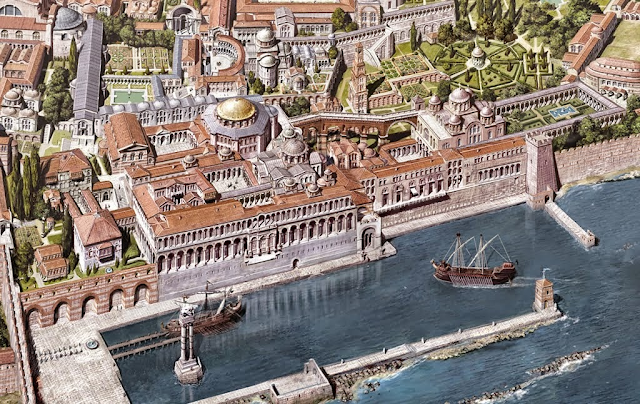The Palace of Boukoleon (Greek: Βουκολέων) was one of the Byzantine palaces in Constantinople (present-day Istanbul). It is located on the shore of the Sea of Marmara, to the south of the Hippodrome and east of the Little Hagia Sophia.
 |
| The Boukoleon Palace as it is today [Credit: Byzantine Legacy] |
The name Boukoleon probably arose after the end of the 6th century under Justinian I, when the small harbour in front of the palace was constructed. According to tradition, a statue featuring a bull and a lion stood there, giving the port its name (βοῦς and λέων are Greek for "bull" and "lion" respectively).
It was registered as a historical monument only in 1982 with the decision of the Supreme Council of Antiquities and Monuments.
 |
| Reconstruction of the Boukoleon Palace [Credit: Byzantine Legacy] |
The survey and restitution projects prepared by the Fatih Municipality were approved on June 27, 2018 dated decision of the Regional Directorate of Conversation. And the Boukoleon Palace Restoration Project was delivered to Istanbul 5th Regional Directorate of Cultural Heritage Conservation on July 25, 2018.
Restoration of the Byzantine Palace will be carried out by the Istanbul Metropolitan Municipality Directorate of Construction Affairs following the approval of the Restoration Project presented to the Istanbul 5th Regional Directorate of Cultural Heritage Conservation.
 |
| Reconstruction of the Boukoleon Palace and the harbour of Theodosius [Credit: Byzantine Legacy] |
Within the scope of the restoration project report presented to the Conservation Board, cement-based mortar, filling material and joints, installation materials on the structure such as cables and pipes, iron joinery door, bars, adjoining walls and such will be removed and cleaned, while the trees, plantations and vines seen on the walls, floor and top of the building will be cleaned as described in the intervention orders.
For the prevention of material and surface losses, it is has been proposed to strengthen and reinforce the structure with proper material by minimizing the intervention on the original texture of the structure. Accordingly, all subsequent ironworks will be removed. All marble surfaces will be cleaned. Structural elements and places with broken parts will be repaired. Sections with material loss will be completed. Repairs will be made where melting and wear are observed. The cement plastered rubble stone wall located between the Boukoleon Palace and the railway will be removed and replaced with a wrought iron fence. In order to ensure that visitors can walk safely without damaging the structure, a wooden walking path will be made.
 |
| After the proposed restoration project, the palace will function as an open-air museum [Credit: Daily Sabah] |
In addition, a wooden bridge will be built at the entrance of the cistern. The park in front of Boukoleon Palace will be removed, and an underground museum structure will be built. In addition, environmental planning and stone pavements will be made for visitors to walk around the structure. The wire fences around the Boukoleon Palace will be removed and replaced with wrought iron fences. The marble block, on the front side of the main entrance door that features the monogram of Emperor Justinian, will be removed and be put back to its original place.
Source: Daily Sabah [August 05, 2018]







No comments: